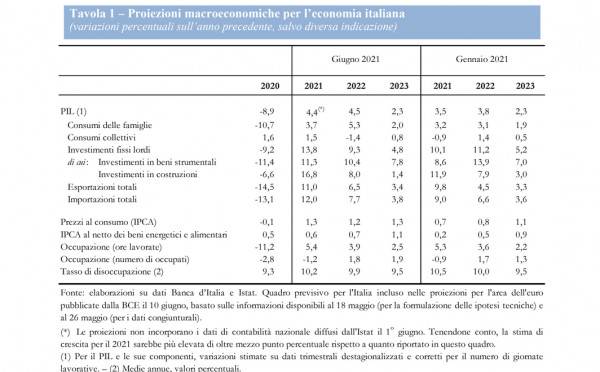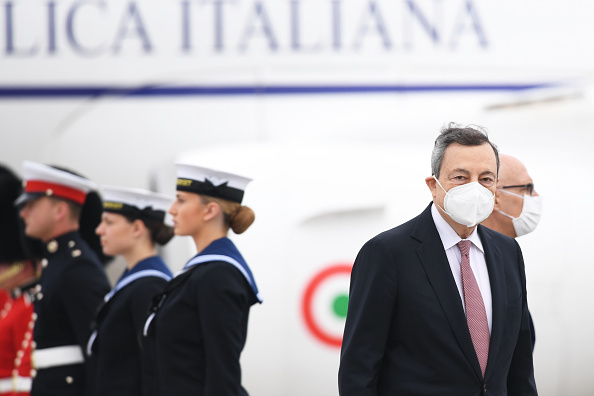Bank of Italy improves the estimates on the growth of the Italian GDP of 2021 and 2022 and also of inflation, simultaneously limiting the outlook on the unemployment rate. This is what emerges from the economic projections on Italy as part of the contribution of the institution of Via Nazionale to the last coordinated financial year of the Eurosystem.
For 2021 it now provides one GDP growth of nearly 5%, equal to at least + 4.9%. For 2022 the forecast is for an expansion equal to + 4.5% and for 2023 Palazzo Koch estimates a moderate increase at the rate of + 2.3%.
The estimates released in January 2021 pointed to an expansion of Italy’s GDP equal to + 3.5%, + 3.8% and + 2.3% in 2021, 2022 and 2023 respectively.
Estimates on inflation growth for 2021 and 2022 have also been improved:
Via Nazionale predicts for 2021 an increase in inflation from -0.1% in 2020 at + 1.3%, + 1.2% in 2022 and + 1.3% in 2023. In the January 2021 outlook, the estimates were respectively + 0.7%, + 0.8%, +1.1 %.
Bank of Italy expects an increase of unemployment rate from 9.3% in 2020 to 10.2%, then a rate of 9.9% in 2022 and 9.5% in 2023. The estimates on the labor market for 2021 and 2022 have therefore been improved, given that the previous outlook predicted an increase in unemployment at 10.5 % in 2021, then a drop to 10% in 2022 and 9.5% in 2023.
READ Pnrr: the first 23 billion euros for six missions are on the way. Debt is still the real problem
The new projections of the Bank of Italy, PNRR Draghi crucial factor
Thus we read in the press release issued by the Bank of Italy:
“The projections, as agreed in the coordinated exercise, are based on information available as of May 18 for the formulation of technical assumptions and as of May 26 for short-term data; therefore they do not incorporate the data released by Istat on 1 June, in which GDP growth in the first quarter of 2021 was revised up by half a percentage point. A broader discussion of the forecast scenario for the Italian economy – which will include the new information that has become available in the meantime – will be presented, as usual, in the Economic Bulletin of the Bank of Italy out next July 16th “. “The projections presented here – continues the press release – assume that the improvement of the national and global health framework continues and that support from monetary and fiscal policies is maintained. It is assumed that a course of the vaccination campaign in line with the plans will make it possible to remove most of the obstacles to mobility by the end of 2021; that the recovery of world trade translates into a robust growth in foreign demand for goods produced in our country (assumed to be 8.8 per cent in 2021 and on average around 5 per cent per year in the following two years); that monetary, financial and access to credit conditions remain very accommodating, with long-term yields that remain very low “.
“The projections presented here – continues the press release – assume that the improvement of the national and global health framework continues and that support from monetary and fiscal policies is maintained. It is assumed that a course of the vaccination campaign in line with the plans will make it possible to remove most of the obstacles to mobility by the end of 2021; that the recovery of world trade translates into a robust growth in foreign demand for goods produced in our country (assumed to be 8.8 per cent in 2021 and on average around 5 per cent per year in the following two years); that monetary, financial and access to credit conditions remain very accommodating, with long-term yields that remain very low “.
“Under these hypotheses – it is explained – the growth of the Italian economy does would strongly strengthen in the second half of the current year, resulting well above 4 per cent in 2021 as a whole, and would continue at a high rate over the next two years. Pre-pandemic activity levels would be recovered within the next year. As mentioned, this estimate does not incorporate the first quarter data released on June 1st, taking into account which growth for 2021 would be more than half a percentage point higher than reported ”.
The upward revision of the outlook depends a lot on the contribution that, according to the Bank of Italy, the Pnrr of the Draghi government will be able to give to the country’s economy. In fact, we read that “this growth profile is highly dependent on the effectiveness of the support and relaunch measures financed with the national budget and with European funds, including those outlined in National Recovery and Resilience Plan (PNRR). In the picture, the combination of these measures raises the level of GDP by about 4 percentage points in the three-year forecast. Half of this impact is attributable to the effects of the PNRR; this reflects the hypothesis that the interventions, in particular the investments, are carried out without significant delays and are effective in supporting the production capacity of the country “.
Bankitalia explains that “in these projections the recovery of the economy it is primarily driven by investments, which are expanding to an accentuated extent thanks to the attenuation of uncertainty regarding demand prospects (as confirmed by the most recent surveys of the Bank of Italy), to the favorable financing conditions and to the support coming from the measures planned under the PNRR . Consumption returns to grow more gradually, with a saving rate down compared to 2020, but still above pre-pandemic levels. The recovery of exports, in line with the trend in foreign demand, is driven by trade in goods, while the recovery of international tourist flows would be more gradual ”.
